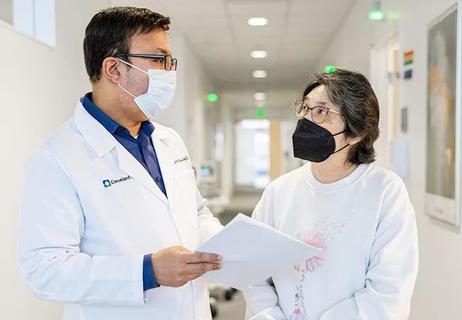Research teams at Case Western Reserve University and Cleveland Clinic’s Department of Hematologic Oncology and Blood Disorders will design and test injectable artificial platelets under a five-year, $1.9 million National Institutes of Health grant.
Cleveland Clinic is a non-profit academic medical center. Advertising on our site helps support our mission. We do not endorse non-Cleveland Clinic products or services. Policy
A team of biomedical engineers at the university, led by Assistant Professor Anirban Sen Gupta, PhD, will refine the design of the artificial platelets’ shape, size and molecular surface modifications to mimic key morphological and functional attributes of natural platelets.
Hematologist Keith McCrae, MD, of Cleveland Clinic’s Taussig Cancer Institute and Department of Cellular and Molecular Medicine, will guide the testing of the platelet designs in biologic models.
Drawbacks of using natural platelets
Natural platelets play a major role in the treatment of many diseases and conditions, including thrombosis, inflammation, the immune response and cancer metastasis. While natural platelet transfusions can effectively manage bleeding, the platelets carry a risk of transmitting infection and disease, and can only be stored for between three and five days.
A new approach to a long-standing challenge
In more than two decades of work on artificial platelet design, researchers have focused primarily on the ability of natural platelets to aggregate. Prior to aggregation, however, natural platelets must adhere to damaged blood vessel surfaces in order to seal the wound and initiate healing.
Dr. Sen Gupta’s lab is among the first to integrate both the adhesion and aggregation functions in an artificial platelet. Dr. McCrae says extensive in vitro testing by Dr. Sen Gupta has already demonstrated the efficacy of his artificial platelet designs.
The next steps
Under the NIH grant, Dr. McCrae’s research team will test various types of artificial platelets, designed by Dr. Sen Gupta and colleagues, in standard mouse bleeding models. “Initial studies will involve measurement of the tail vein bleeding time,” Dr. McCrae says, “though we may extend testing to other models as well.”
The goal is to optimize the design of the artificial platelets. “We want to enhance circulation times after injection, enable precise localization to sites of wounding and recruitment of additional native platelets to those sites, and support other hemostatic pathways,” he says. Researchers also hope to define in detail the mechanisms that underlie those effects.
It would be ideal if these advances lead to artificial platelets that could be directly tested in humans, he says. However, agencies like the FDA will most likely want to see efficacy in larger animal models prior to human exposure.
Unlimited applications
The potential applications of artificial platelets are virtually unlimited, Dr. McCrae says. “They have the ability to treat any patient with a deficient number or function of their native platelets,” he says, citing uses in diseases such as leukemia, immune mediated platelet destruction and in trauma patients in the field. While the former often become refractory to donor platelets, the latter require a formulation that, unlike native platelets, can be stored for prolonged periods of time.
According to Dr. McCrae, the possibilities are very important and potentially viable. “There’s a great need for an artificial platelet than can work in a variety of disease scenarios,” he says. “This is an exciting time in platelet research.”

First-of-its-kind research investigates the viability of standard screening to reduce the burden of late-stage cancer diagnoses

Study demonstrates ability to reduce patients’ reliance on phlebotomies to stabilize hematocrit levels

Findings highlight an association between obesity and an increased incidence of moderate-severe disease

Cleveland Clinic Cancer Institute takes multi-faceted approach to increasing clinical trial access

Key learnings from DESTINY trials

Gene editing technology offers promise for treating multiple myeloma and other hematologic malignancies, as well as solid tumors

Study of 401,576 patients reveals differences in cancer burdens as well as overall survival

Enfortumab plus pembrolizumab reduced risk of death by 53% compared with platinum-based chemotherapy